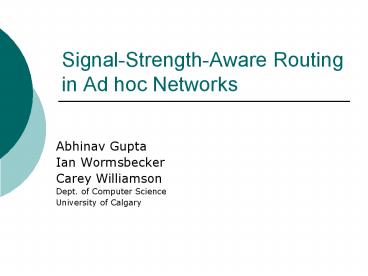SignalStrengthAware Routing in Ad hoc Networks - PowerPoint PPT Presentation
Title:
SignalStrengthAware Routing in Ad hoc Networks
Description:
Signal-Strength-Aware Routing in Ad hoc Networks. Abhinav Gupta. Ian ... Signal-strength-aware AODV is a good choice for ad hoc networks because of low ... – PowerPoint PPT presentation
Number of Views:70
Avg rating:3.0/5.0
Title: SignalStrengthAware Routing in Ad hoc Networks
1
Signal-Strength-Aware Routing in Ad hoc Networks
- Abhinav Gupta
- Ian Wormsbecker
- Carey Williamson
- Dept. of Computer Science
- University of Calgary
2
Ad hoc Networks
- An ad hoc network is dynamically formed when two
or more mobile hosts with wireless capability
come into transmission range of each other - Advantage of ad hoc networks
- Can be set up on-the-fly
- Requires no existing infrastructure
3
Ad hoc Network
4
Objectives
- Implementation of Signal-strength-aware AODV
- Study the effect of AODV routing, user mobility,
and number of hops on TCP throughput. - Study the effectiveness of rate-based-pacing of
TCP (TCP-RBP)
5
AODV Operation
Data
Data
RREQ
Source
RERR
RREP
Destination
6
Ad hoc On-Demand Distance Vector Routing Protocol
(AODV)
- Reactive in operation
- Route discovery and maintenance using control
packets (RREQ, RREP, RERR and HELLO) - The route freshness determined using sequence
numbers associated with the control packets.
7
AODV UU
- Implementation carried out in user-space.
- Consists of 3 kernel modules and some user space
modules. - Uses Netfilter hooks for packet mangling from
kernel space to user space. - Packets analyzed in user-space to trigger AODV
events. - Packets are queued on to user-space using libipq
which communicates with ip_queue, standard queue
handler for IPv4.
8
AODV Modules
9
Signal-strength-aware AODV
- Rationale Dont allow route freshness to be
determined solely on the basis of sequence
numbers - Checks signal strength of control packets coming
from adjacent Mobile Host to before it creates,
updates or deletes routes. - Signal strength of control packets determined by
link_strength module and used by aodv_socket to
choose whether or not to let the packet through.
10
Variation of Signal Strength
11
Operation
- If the packet is a broadcast or is intended for
the current host, then it is handled as usual by
Linux. - If the packet is not intended for the current
host and a route exists, it is forwarded to the
next hop. - If no route exists, the packet is dropped.
- If the packet is generated by the local host, it
is buffered in user-space, and a route discovery
initiated and routed to next hop when a route is
found.
12
Locally Generated Packet
Packet
NF_IP_LOCAL_OUT
13
Experimental Environment
- Redhat Linux 8.0 (kernel 2.4.18-14)
- 5 laptops
- 3 IBM Thinkpads (Processor P4)
- 2 Compaq Evos (Processor P3)
- Cisco Aironet 350 PCMCIA Wireless Cards
- Netperf and Netserver used as source and sink for
TCP traffic. - Kernel Probes added to TCP code to monitor the
TCP statistics - Airopeek Sniffer used to count the control packets
14
Testbed Topology
Node1 Running netserver
Node2
Node3
Node5 Running netperf
Node4
Airopeek Sniffer
15
Routing Discovery Time (ms)
16
Round Trip Time
17
TCP Throughput (Mbps)
Slow Speed 0.33 m/s Fast Speed 1.0m/s
18
Routing Overhead
19
TCP rate-based-pacing (TCP RBP)
- Rationale Spread-out the TCP Packets in time
to improve TCP performance - InterPacketDelayRTT/(CurrentWindowV)
- Performed simulations and experiments with Reno
TCP and RBP TCP - Related Work
- 1 Z.Fu et al, The Impact of Multi-hop
Wireless Channel on TCP Throughput and Loss,
Proceedings of IEEE INFOCOM03, San Francisco,
April 2003 - 2 J.Ke and C.Williamson, Towards a Rate-Based
TCP Protocol for the Web, Proceedings of MASCOTS
2000, San Francisco, pp. 36-45, October 2000
20
TCP rate-based-pacing
Packet
Packet
Packet
21
Simulations Results (TCP-RBP)
22
Experimental Results
- TCP Throughput (Mbps)
23
Conclusions
- Signal-strength-aware AODV is a good choice for
ad hoc networks because of low overhead and good
performance - Design choices made for signal-strength-aware
AODV were effective - Performance of RBP TCP is highly sensitive to
channel contention and AODV routing dynamics - Simulation results should be interpreted with
caution, unless validated against experimental
measurements
24
Thank You!
25
Contributions
- Provides a working implementation of
signal-strength-aware AODV - Demonstrates the functionality and performance of
the protocol - Presents empirical measurements of TCP throughput
in multi-hop wireless ad hoc network - Evaluates the effectiveness of TCP
rate-based-pacing in an experimental setting






















![[AD Hoc Networks] PowerPoint PPT Presentation](https://s3.amazonaws.com/images.powershow.com/8371435.th0.jpg?_=20161231113)








